Conversational AI in healthcare
What is conversational AI and how are healthcare providers using it to provide a better patient experience on digital channels like their websites and social media channels. Keep reading to learn more, or book a product tour of Dialpad's AI-powered customer engagement platform to get a hands-on look at how it works!
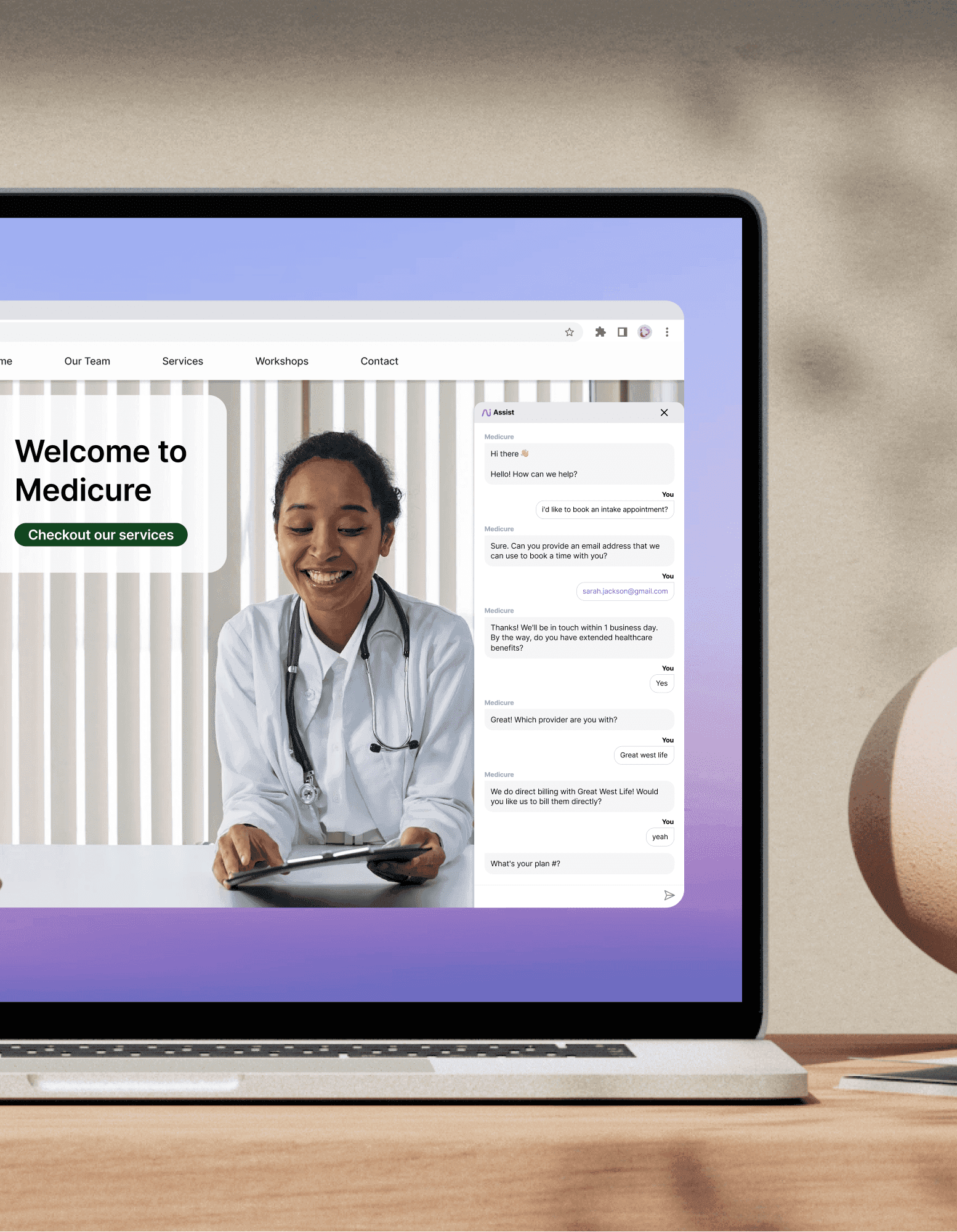
Though we are still relatively early in AI development stages, the healthcare industry is already beginning to adopt conversational AI in a variety of different ways.
Many people may think of AI-powered chatbots when they hear about conversational AI technology, but the reality is that healthcare providers can do a lot more with it than just automate scripted conversations on a website.
From offering patients faster and more efficient care to improving productivity and reducing costs for clinics and hospitals, there are many possible applications of conversational AI in healthcare—and we’re only scratching the surface.
In this guide, we’ll dive into these use cases and explore the considerations for healthcare practices that are interested in this technology.
What is conversational AI for healthcare?
Conversational AI is a type of artificial intelligence that can interact with patients and other stakeholders in an automated way, which relieves some of the burden on busy healthcare providers.
In a healthcare setting, conversational AI can be used in a variety of ways, including providing patient education, streamlining administrative tasks, and automating customer service interactions. More specifically, it can help in managing patient intake, appointment scheduling, and providing relevant educational resources for patients. (More on this in the use cases section below.)
Using natural language processing (NLP), natural language understanding (NLU), and machine learning algorithms, conversational AI can quickly analyze large amounts of data (for example, past patient conversations) and provide a wider variety of helpful responses to patient questions compared to traditional rule-based support chatbots.
Considerations for healthcare practices that are interested in conversational AI
Conversational AI, which includes chatbots and virtual assistants, can provide a host of benefits to healthcare organizations, from improving patient care to increasing productivity for clinics and hospitals. For those interested in implementing conversational AI, there are a few key considerations that need to be taken into account.
What are you hoping to accomplish with conversational AI?
Before you start looking at different vendors or types of conversational AI technology, you should first have an idea of what problems you’re trying to solve with AI.
Do you manage a hospital that receives a high volume of calls and messages from patients on a daily basis, that your team isn’t able to respond to quickly enough?
Or are you a regional or provincial health authority that needs to be able to share important public health information at scale in an automated way?
Knowing what your goals are will help you focus your efforts and attention on the specific conversational AI tools that are built to solve those challenges. Otherwise, it’s easy to get overwhelmed by the ever-increasing number of healthcare AI solutions available.
What communication channels do you need?
With conversational AI, these conversations have to be happening somewhere.
Whether these are through phone calls, video calls, SMS/MMS messaging, live chat, or social media channels, a key consideration when you’re implementing conversational AI is which of these channels you’ll want the AI to analyze insights and answer questions for.
Healthcare organizations often have large amounts of conversational data from phone calls, live chat messages on their websites, and more—generally, it’s beneficial to have a centralized AI-powered communications platform that can manage all these channels instead of a group of disparate systems and apps that all need to be integrated together.
Not only is this more cost-effective, it’s also less time-consuming for staff to learn and use this technology because it offers a singular user experience, as opposed to being forced to learn and toggle between different tools constantly.
How will it help you maintain compliance?
Thirdly, consider how you will maintain compliance with a conversational AI system.
Most countries have some form of healthcare privacy legislation, from HIPAA in the United States to The Privacy Act 1988 in Australia.
Long story short, there will always be security and privacy concerns when dealing with sensitive patient information, and conversational AI solutions will need to be able to help healthcare organizations maintain compliance and make sure that any conversation intelligence uncovered from patient interactions stay secure and protected.
How will you measure performance or success?
Finally, think about what success looks like with your conversational AI implementation.
For example, you could track various patient experience metrics to improve the quality of care and reduce burden on your staff. Metrics such as call volume and response time, conversation length, patient satisfaction (CSAT), and first contact resolution can be measured and analyzed to evaluate the effectiveness of patient interactions.
As we touched on earlier, conversational AI can be used to solve a wide range of different healthcare challenges. To keep your strategy efficient and airtight—and to ensure that you get maximum value from your investment—focus on your key indicators of success early on.
The current state of conversational AI In healthcare
Right now, conversational AI’s use in healthcare is growing at an increasingly rapid rate. As the technology gains more traction and credibility, healthcare providers are beginning to feel more comfortable exploring different tools and realizing the potential benefits it offers.
According to a survey in late 2021 by Optum, a healthcare insurer, about 85 percent of healthcare leaders say that their organizations already have an AI strategy, and almost half of respondents said they’re already using AI technology.
It’s not surprising, as Accenture found that AI applications in healthcare could create an estimated $150 billion in annual savings for the US healthcare economy by 2026.
That being said, conversational AI adoption in healthcare is far from reaching critical mass, and there are still compliance and security requirements that are evolving as healthcare providers, hospitals, and other organizations better understand how these tools can be used.
Top 6 use cases of conversational AI In healthcare
From automating daily administrative tasks for clinic or hospital staff, to helping physicians make more accurate diagnoses more quickly, conversational AI can take on quite a large variety of tasks for not only doctors, but also nurses, surgeons, medics, therapists, and more.
1. Improving patient service
Conversational AI can provide 24/7 service and support, and can be used to answer general patient questions, provide appointment reminders, and handle other administrative tasks that would otherwise require staff time and resources.
But not only that, larger healthcare organizations that receive high call volumes or questions on their websites can also use AI to deflect and respond to many questions. Not to mention the fact that almost 70% of consumers expect healthcare providers to engage with them in real-time.
For example, conversational AI (essentially a more advanced and versatile chatbot) can do things like handle initial patient intake, automate appointment scheduling, and connect staff to helpful internal knowledge sources to provide answers to FAQs and help patients access self-service resources first.
A good cloud contact center platform will let you design these conversational flows to handle your most common queries from patients. For example, with Dialpad Support, you can create flows like this with the drag-and-drop builder, no coding needed:
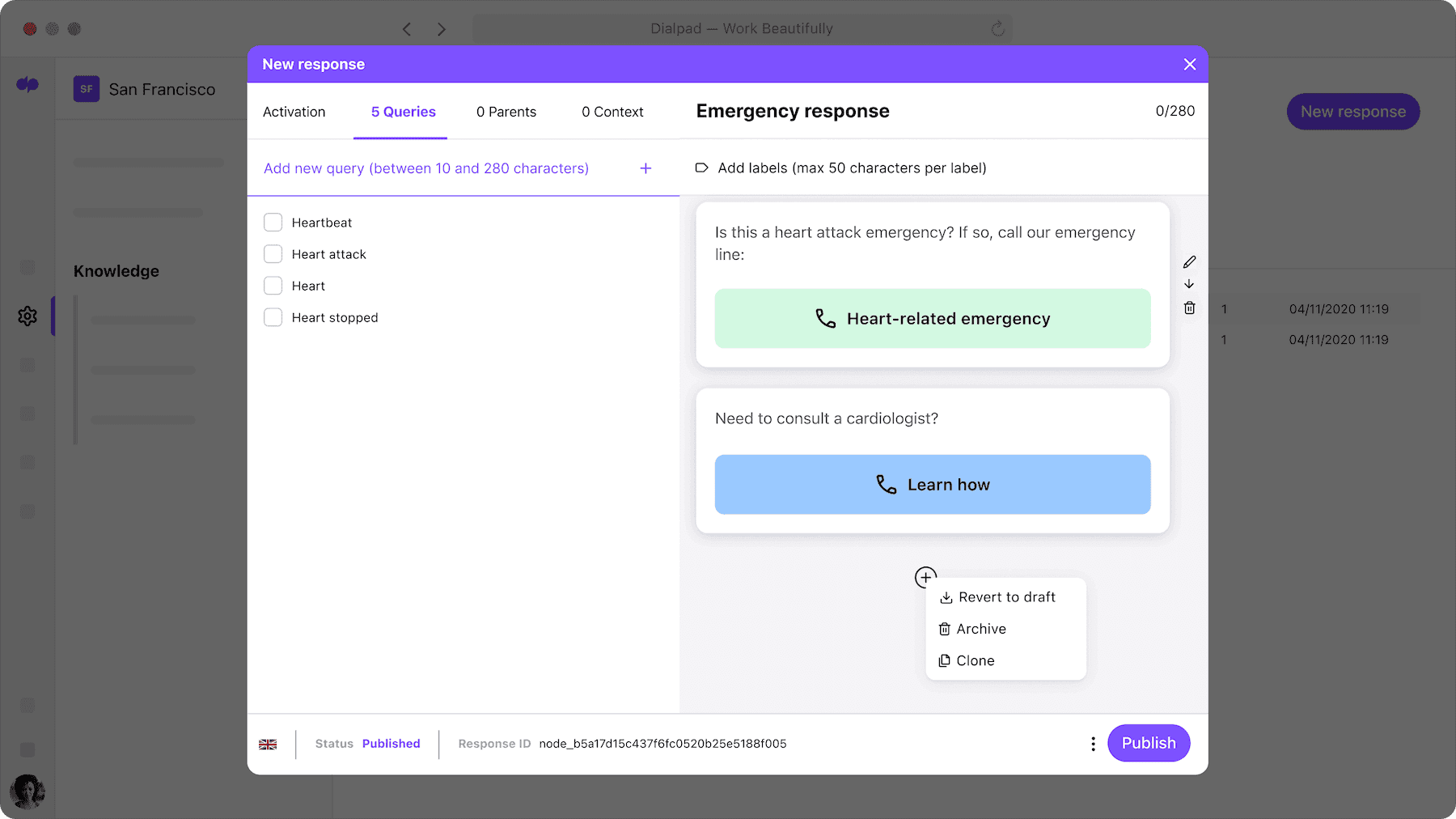
On top of that, AI can also analyze sentiment of calls in real time, which not only empowers agents to deliver empathetic support, but also helps healthcare providers quickly identify patients in distress or those with urgent issues and provide prioritized assistance.
For example, CSAT surveys (customer satisfaction surveys) are one of the most commonly used tools, across all industries, to measure how satisfied clients are with their interactions with a business. Generally, CSAT surveys are sent to clients or patients immediately after an interaction like a support call or a live chat conversation.
However, one of the biggest challenges with collecting CSAT scores is that not a lot of people actually fill out these surveys.
In fact (depending on the industry and specific business of course), we've found that on average only about 5% of people actually fill out CSAT surveys. On a related note, usually only the angriest—and happiest—customers actually bother to respond to these surveys, which means your CSAT answers are likely to be very skewed and not representative of how your clients feel overall.
Dialpad's industry-first Ai CSAT feature is designed to solve exactly that. Not only can the AI transcribe calls and analyze sentiment in real time, it can also infer CSAT scores for 100% of client calls. The result: a much more representative sample size for CSAT scores, and a more accurate understanding of how satisfied your patients really are:
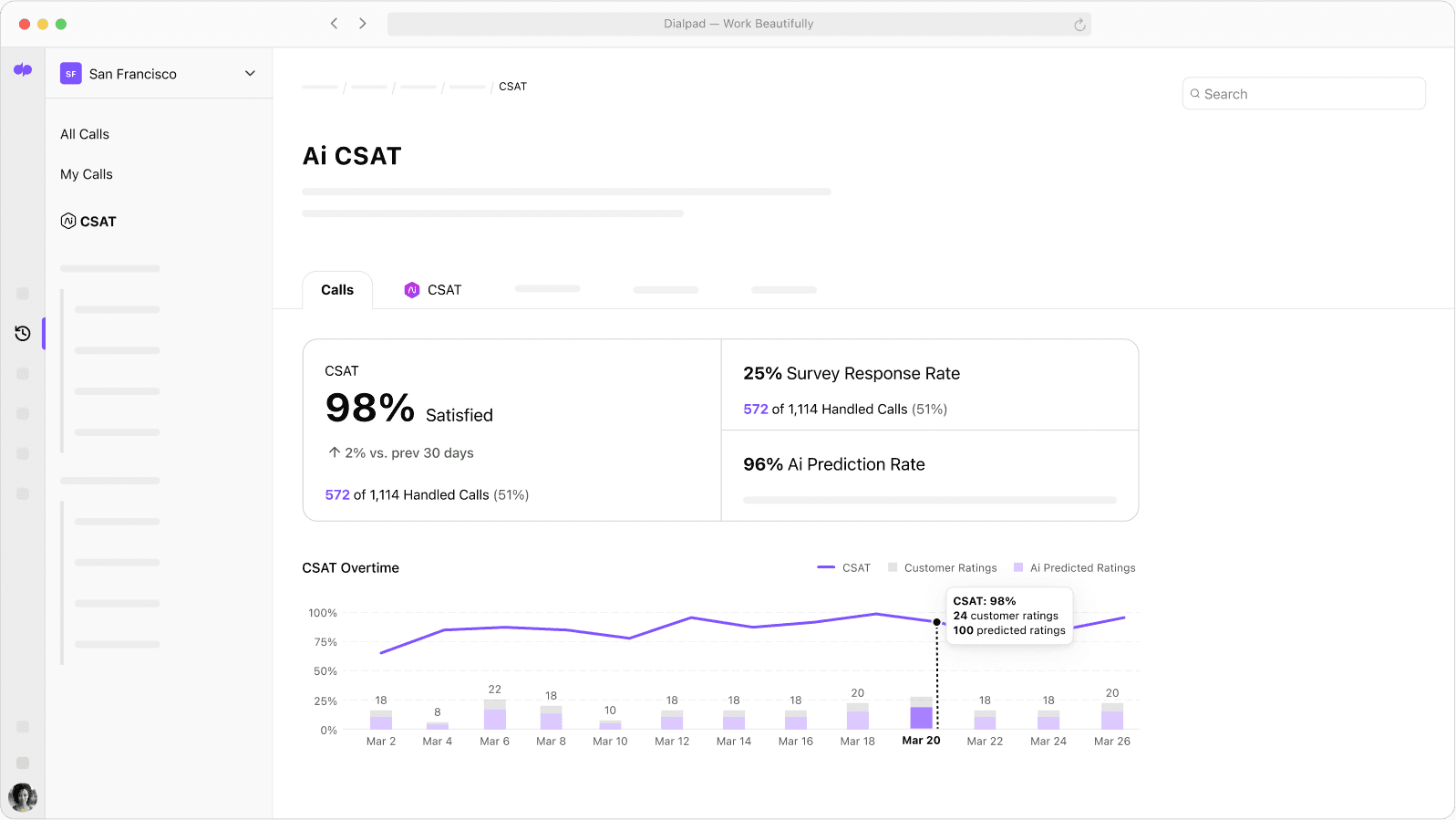
2. Speeding up processes such as billing and insurance processing
On a related note, conversational AI can also help speed up time-consuming processes like billing and insurance processing.
For example, a clinic could automate this step as part of the appointment scheduling process. A patient who wants to book a time with a physician or specialist could do this through conversational AI on the clinic’s live website chat or even a digital channel like WhatsApp.
Once they’ve confirmed the appointment, the conversational AI would automatically prompt the patient to add their health insurance information, if any, so the clinic could directly bill the provider instead—which saves the patient both time and effort:
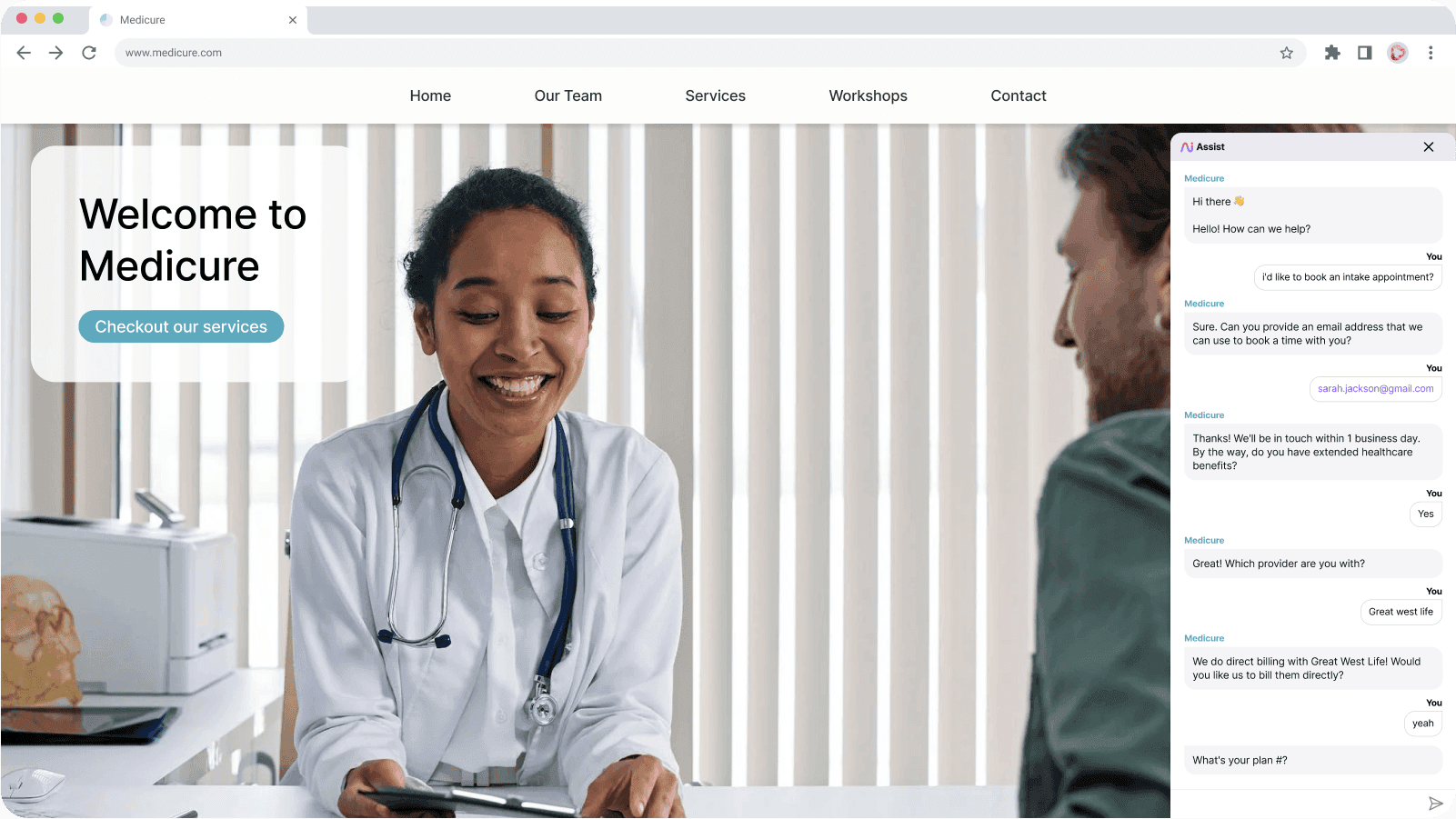
3. Uncovering patient feedback and other insights
You’re already having conversations with patients and prospective patients every day. There’s likely a significant amount of valuable insights and learnings that your organization can glean from these calls and chats.
Where are there gaps in your patient experience? What did patients like or dislike about their interactions with your team?
For example, with Dialpad's customer engagement platform a rehabilitation center can track how frequently different topics or keywords crop up in conversations with clients by creating “Custom Moments.”
If the team wants to see how many inpatient or outpatient-related conversations are happening, they can create a Custom Moment to track how often “inpatient” or “outpatient” is spoken on a call:
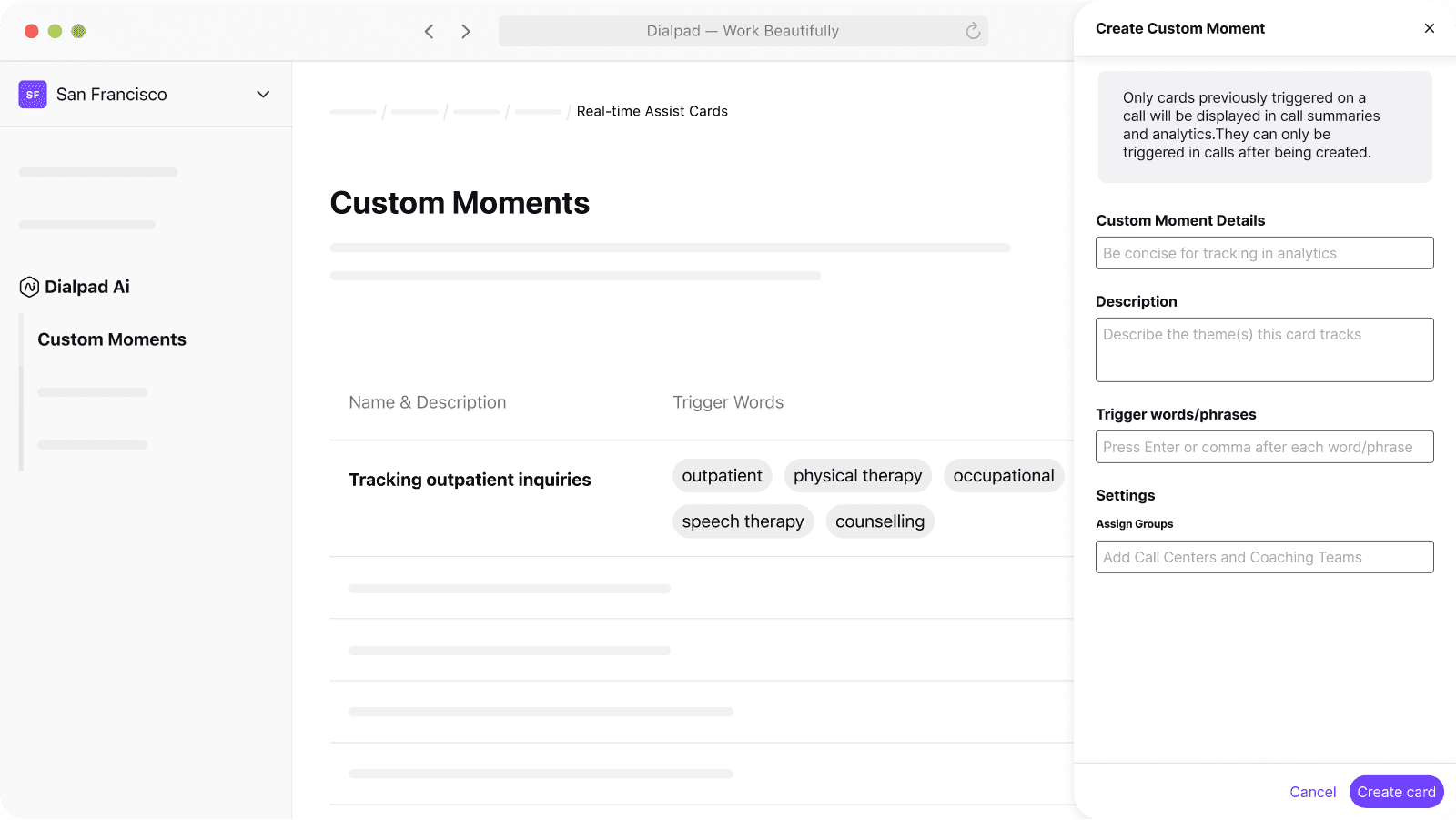
Dialpad Ai will then track occurrences of these topics and show whether there are spikes in interest or other patterns that may help the healthcare provider make data-driven decisions about hiring or expanding to meet patient demand.
4. Quality assurance for patient interactions
For almost all healthcare providers, quality assurance is essential. Supervisors may use QA scorecards to evaluate patient interactions such as intake calls or consultation sessions, and provide feedback based on specific metrics, such as responsiveness, empathy, and understanding of patient needs.
Through conversational AI, supervisors can more easily evaluate agent performance by reviewing AI-generated calls summaries, identify trends in patient inquiries, and pinpoint areas for agent training and improvement.
5. Patient triage and symptom assessment
We’re hearing about hospitals and doctors being more and more overwhelmed every day—and patient triage is a task that can sometimes take quite some time.
There are already examples of AI virtual assistants that can perform initial patient assessments by asking relevant questions, collecting information about symptoms, and helping prioritize cases based on urgency.
Researchers from Babylon Health, for example, developed an AI virtual assistant that does exactly this (i.e. giving patients triage and diagnostic information)—and more importantly, found that the AI’s level of clinical accuracy and safety was “comparable to that of human doctors.”
As AI-powered symptom checkers online (see an example of this in the next item on this list) become more sophisticated, we’ll likely see faster diagnoses for patients, especially those who may have neurodegenerative diseases or other illnesses with a complex or broad constellation of symptoms.
6. Information dissemination
From pandemics to other health emergencies, public health authorities are often faced with a tall task: clearly communicating to the general public how to keep themselves safe—and often, they have to combat misinformation at the same time.
But most physicians, medical officers, and healthcare professionals simply don’t have the time to personally host webinars or other learning sessions. Here, conversational AI can quickly disseminate helpful (and sometimes life-saving) information, at scale.
The CDC (Center for Disease Control) in the United States, for example, used a conversational AI chatbot to help citizens do a quick self-check for whether they had COVID-19 in order to reduce the potential number of people heading to urgent care or emergency care when it wasn’t necessary:
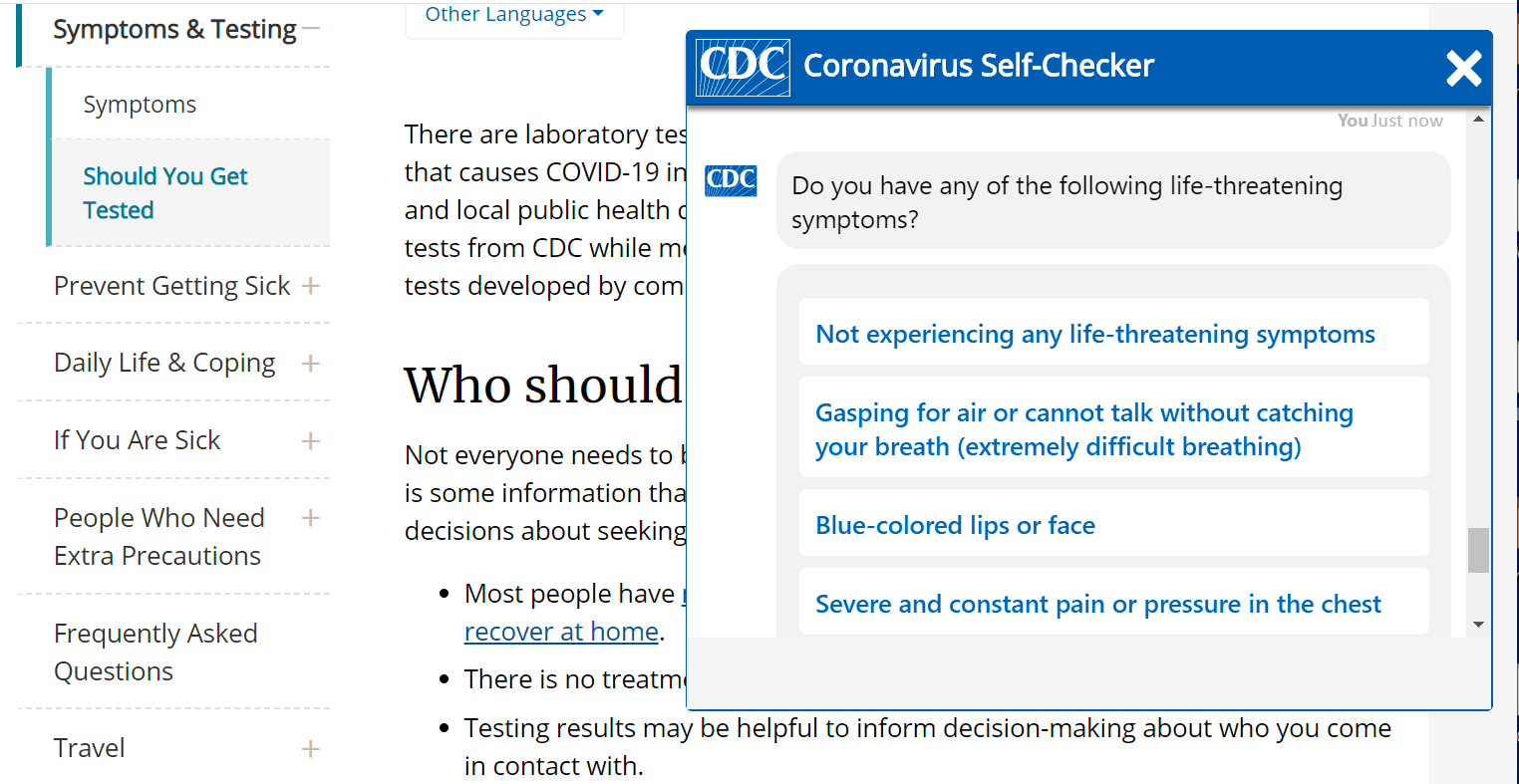
Beyond helping overwhelmed hospitals and clinics, conversational AI can also help answer many common questions about diseases or health concerns, share preventative measures, government updates, and more—across a wide variety of online platforms like WhatsApp, live chat on websites, and other social media channels.
The benefits of using conversational AI in healthcare
The use of conversational AI in healthcare offers numerous benefits to both patients and healthcare organizations.
Faster access to care for patients
For patients, the most significant benefit is that it enables quicker access to care. These virtual assistants can help with automated appointment scheduling and knowledge sharing, and give patients quick and easy self-service options (which also reduces wait times significantly).
For practices and hospitals that are overwhelmed with inquiries, conversational AI can be used to provide an ideal blend of automated service that still feels personal for patients.
Increased operational efficiency for healthcare providers
For healthcare providers, conversational AI offers a number of operational benefits as well. It can streamline appointment scheduling processes by automatically screening calls and routing them to the appropriate personnel or departments.
Not only that, it can make suggestions that can accelerate accurate triaging for disease diagnosis and medical advice.
Improved patient engagement
Finally, conversational AI enables improved patient engagement by giving them more options to communicate with their healthcare providers, while also helping providers collect feedback from patients about their experience or care plan. This feedback can then be used to both improve patient satisfaction ratings and lead to better overall health outcomes.
How can you provide a better patient experience with AI?
Conversational AI is becoming an increasingly important tool for healthcare organizations, and the use cases for this technology are ever expanding.
From automating parts of the patient experience to improving overall patient engagement, conversational AI presents many advantages for patients, healthcare providers, and organizations alike.
The potential benefits of using conversational AI in healthcare are numerous, but it’s essential that organizations understand both the capabilities and limitations of the technology, and how they can use it in a secure way to increase efficiency, reduce costs, and most importantly, improve patient care.
Whether your practice is an early adopter when it comes to healthcare technology or more cautious, it’s not too early to start thinking about the implications of AI and how it can improve patient communications and productivity.
If you’re interested in learning more about how organizations in regulated industries like healthcare and law are already using AI, reach out to our team!
Get a hands-on look at conversational AI in healthcare
Book a demo of Dialpad with our team, or take a self-guided interactive tour of the app first!
